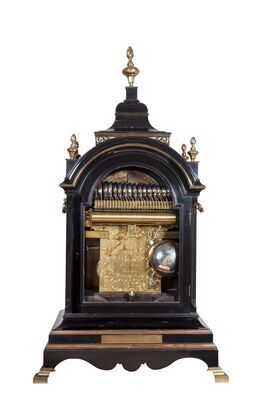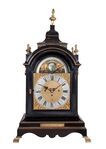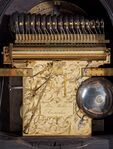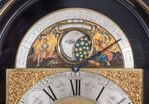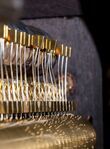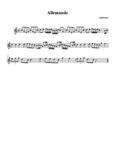Details
TitleBell-Playing Table Clock
Creator Allin Walker (watchmaker)
PlaceAmsterdam (The Netherlands)
Year ca. 1750
Object number0203
Object categorymechanical instruments with bells, timepieces with musical movements
Object nametimepiece with bells, table clock
DescriptionIn this table clock, the hour striking is preceded each time by a melody. In the lunette above the chapter ring is a hand that can be manually set to one of eight musical titles engraved in silvered brass. The principle of "Dutch striking" applies here. This indicates that a large bell is struck at every full hour, and a small(er) bell at every half hour.
Accompanying textsBells have the characteristic of containing many overtones. In addition, they are usually not muted and thus sound for a relatively long time after being struck. As a result, melodies on bell-playing clocks were, out of necessity, usually quite plain - either in unison or with a simple accompaniment. Usually Dutch bell-playing clocks play popular Dutch songs. This does not always mean that these tunes originated in the Netherlands; often they originated in France and sometimes in England, but then became popular here with new Dutch song lyrics. The playing work contains eight tunes programmed side by side on the cylinder.
A table clock like this one would have been a true showpiece for its owner. Such owners were mostly part of a wealthy, 18th-century middle class who had worked their way up a century earlier during the flourishing trade era. These table clocks were markers of status: it was something significant to own such a technical masterpiece. After all, not everyone was in a position to purchase something like this. Both the front and back were fitted with a glass door so that you could look at the technology. Not infrequently, therefore, clocks like this one were displayed in the living room with a mirror behind them, for example on a mantelpiece or, as the format of this clock suggests, a table. Allin Walker, who made this clock (as evidenced by the signature), was one of the last important (of many) English clockmakers working in Amsterdam in the 18th century.
A table clock like this one would have been a true showpiece for its owner. Such owners were mostly part of a wealthy, 18th-century middle class who had worked their way up a century earlier during the flourishing trade era. These table clocks were markers of status: it was something significant to own such a technical masterpiece. After all, not everyone was in a position to purchase something like this. Both the front and back were fitted with a glass door so that you could look at the technology. Not infrequently, therefore, clocks like this one were displayed in the living room with a mirror behind them, for example on a mantelpiece or, as the format of this clock suggests, a table. Allin Walker, who made this clock (as evidenced by the signature), was one of the last important (of many) English clockmakers working in Amsterdam in the 18th century.
Dimensions
geheel height: 106 cm
geheel width: 59.5 cm
geheel depth: 39.2 cm
cilinder length: 29 cm
cilinder diameter: 5 cm
geheel width: 59.5 cm
geheel depth: 39.2 cm
cilinder length: 29 cm
cilinder diameter: 5 cm
Keywordsprogrammadrager: cylinder
geluidsbron: bells
aandrijving: spring
aandrijving? fusee
echappement: verge escapement
geluidsbron: bells
aandrijving: spring
aandrijving? fusee
echappement: verge escapement
Digital references

